COVER STORY

Students take on the Big Apple — Cornell's urban lab
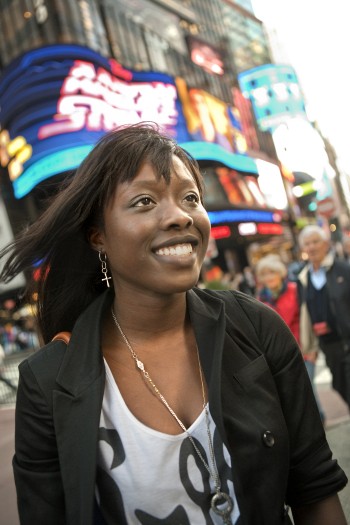
Maria Teresa Asare-Boadi 11, a student in the Cornell Urban Semester Program, in the lights of Times Square across the street from the site of her internship at MTV Networks. See larger image
His laboratory equipment consists of a fat notebook and a stone park bench in East Harlem. Huicheng Zhong has logged many hours sitting here in the Dr. Ronald E. McNair Playground, watching everything and everyone, and writing down what he sees.
The children splashing in the fountain and running around on the patch of artificial turf (there is no real grass here) show no interest in the tall man from Guangzhou, a metropolis in southern China, and his stacks of charts and maps, but his work could one day change the way their playground looks.
A graduate student in landscape architecture at Cornell, Zhong has come to New York City to study how people interact with open space when there isn't much of it to spare.
He is preparing an analysis of how people use this park and 73 others in Harlem for the Manhattan Community Board 11, an independent city agency, and his internship sponsor last summer through Cornell's Urban Scholars Program. This kind of research helps the city design new parks and renovate old ones in ways that make sense. Zhong's data concentrate on revealing patterns created by people. "At the same time, the design of the park drives that pattern," he says. "There is a lot of potential for improvement."
New York City is the urban laboratory that makes Zhong's fieldwork possible. For him, as for the hundreds of Cornell students and faculty who can be found here at any given time, the city can be many things: A place to collaborate, an inspiration, an eye-opener -- and a necessity.
It is for all these reasons that Cornell maintains a vibrant, visible and growing presence in New York City.
A contrast in studies
Ithaca and New York City are 223 road miles from one another, but distance may be the least of what separates them. New York exists on a colossal scale. The population of Ithaca is 30,000 to New York's 8.3 million. Ithaca's TCAT bus system moves 3 million riders a year -- about the same number as the New York City subway system on a typical Saturday. Indeed, with 45,000 alumni living or working in the metro area, New York City even has more Cornellians than Ithaca itself, and many of them stay involved by enabling students to work and study as part of their organizations.
Today, Cornell capitalizes on the city's vastness and diversity to provide more opportunities for students than ever before, but its relationship with the Big Apple is a longstanding one.
Cornell has had students in New York City since at least 1898, the founding year of Weill Cornell Medical College (see related story, page 9). Although the medical school is still the conspicuous face of the university in the city and the nexus of scientific collaborations between researchers in Ithaca and Manhattan, a growing number of Cornellians can be found in all five boroughs, engaged in a remarkable number of disciplines.
"They just never end, our collaborations down in New York City," says Alan Mathios, the Rebecca Q. and James C. Morgan Dean of the College of Human Ecology. "New York City provides a natural learning-living environment that is relevant to a significant portion of the research, education and outreach mission of the college and university.
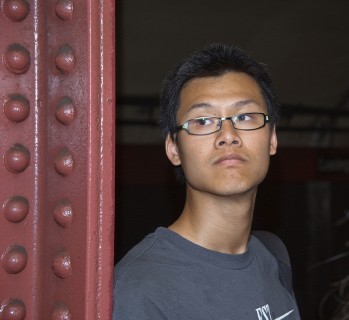
Graduate student Huicheng Zhong during a walking tour of Manhattan. See larger image
"For example, significant coursework in the college is devoted to poverty alleviation, inequality and health disparities. The students get trained in these general areas [in Ithaca], but when they are in New York City they see the issues for real and develop a deeper respect for the importance of the curriculum."
Cornell-affiliated offices and programs in New York include Human Ecology and Cooperative Extension-New York City, which runs a multimillion-dollar operation in nutrition education and research (see related story, page 13). The ILR School has an office in New York (see End Note, page 29), as do the College of Architecture, Art and Planning and the College of Engineering's School of Operations Research and Information Engineering.
Add in the huge number of less formal exchanges -- from faculty speaking engagements and students doing internships to research collaborations -- and Cornell's overall NYC footprint becomes virtually impossible to calculate, says Brenda Tobias, director of the communications office Cornell opened in the city in 2005.
New York City's cosmopolitan environment is especially attractive to students like Maria Teresa Asare-Boadi '11 and Kristen Tauer '10, who wish to explore career options that simply aren't available in rural areas or smaller cities. They are two of 18 students in New York City as part of the College of Human Ecology's nearly 40-year-old Urban Semester Program, earning 15 credits through internships, community service and fieldwork supporting their academic study.
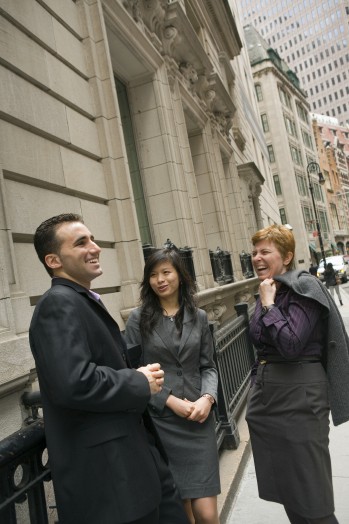
Victoria Averbukh, right, director of the Cornell Financial Engineering Manhattan program, chats with students Raymond DiFelice, left, and Di Li in the financial district. See larger image
A boot-camp experience
Asare-Boadi is not a rock star, but she has been dutifully instructed on what to do when she encounters one. "You are an employee. You are expected to act professional," she says. But it might be tough if she crosses paths with Justin Timberlake or another of the pop stars who routinely drop in at MTV Networks.
The interior design major in the College of Human Ecology is working for a semester in the planning and design department at the music channel's famous studio in Times Square.
Aside from the movie premiere that she was invited to attend on the Paramount Studios floor of her building, her work so far has been unglamorous -- sorting fabrics, filing, answering telephones. But for a student of interior design, she says, being embedded in a workshop with so much creativity and freedom is a priceless experience and a huge résumé builder.
"Each floor has its own identity," she says, admitting that she sometimes punches unnecessary buttons in the elevator just to see what will greet her when the doors open. "Our floor has grass on the wall. The Nickelodeon floor has a huge SpongeBob that just stares at you."
Meanwhile, Kristen Tauer, a communication major, is continuing on a path that began in third grade when she started teaching herself HTML so that she could hand code Web pages. Around that same time, she would watch movies and TV shows, sketching the outfits the characters were wearing. She was an online fashion editor in the making.
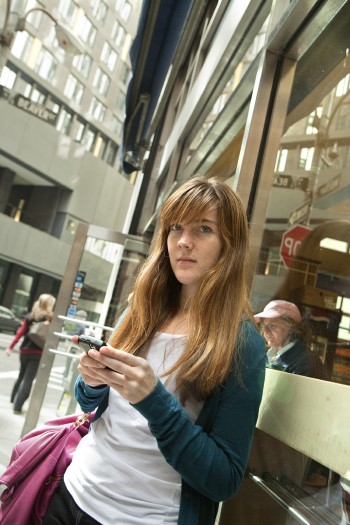
Kristen Tauer 10, is spending the fall semester in the Cornell Urban Semester Program as an intern with Lucky magazine at Cond Nast in Times Square. See larger image
Now, she is an intern at Lucky magazine. Three days a week, she walks into the Condé Nast building at 4 Times Square, where some of the world's leading tastemakers have their offices at such publications as GQ, Vogue, Allure and Vanity Fair.
Although her internship started during the fall New York Fashion Week, her internship duties kept her from attending the Bryant Park extravaganza. One project she's working on is an online feature (and possible future iPhone application) that would categorize and rank the best boutiques in America.
"I want to go into fashion journalism, and I can see if I like that path," Tauer says. "I don't really have the skills to be a designer, but I just love high fashion. To me, it is an art, and it tells you a lot about the social climate we're in."
In addition to three days a week at internships, Tauer and Asare-Boadi spend time working with children at schools in North Brooklyn and meeting with community leaders. Sam Beck, the Urban Semester Program's director, says his students -- half of them pre-meds doing clinical rotations at Weill Cornell Medical College -- undergo a "heightened maturation process" while they are in the city. One reason, he says, is that they spend a lot of time together, reflecting on what they are learning and experiencing.
"Clearly, being in New York has its own benefits," Beck adds. "It's an intense environment. You're running into incredible differences. Every language group that you could possibly imagine is in New York City, and you're running into them constantly. The subways are packed. You are constantly negotiating personal space. And then, of course, you're dealing with not only the physical environment, but you're also dealing with the newness of the professional environment.
"It's like a boot-camp experience, except it's self-inflicted."
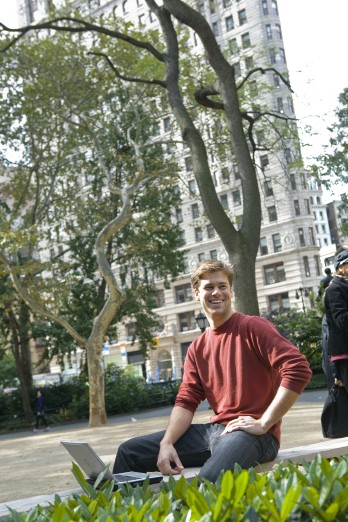
Architecture student Tim Liddell 10 in Madison Square Park with the Flatiron Building in the background. Liddell is one of Cornells Life on the Hill student bloggers and is chronicling his experiences online. See larger image
It's all about location
Sometimes, if you want to compete at the highest level of your field, being in New York City is an academic necessity. Such is the case for Cornell Financial Engineering Manhattan, part of the School of Operations Research and Information Engineering.
Its offices are in the Financial District in Lower Manhattan, the central nervous system of American capitalism. Three stories above Broad Street's seemingly endless parade of suits, starched collars and BlackBerry addicts, Victoria Averbukh is explaining to her students how to calculate the forward price of a coupon bond. "People in the back row," she calls, immediately causing them to perk up behind their empty coffee cups. "How should you know what the repo rate is?"
They are here to become "quants" -- Wall Street speak for quantitative analysts, or numbers people. This is their last semester in Cornell's master's program, spent within walking distance of the companies where almost all of them will land after graduation. Averbukh, herself a former investment banker, directs the program.
"Most of the courses are taught in the evening by industry practitioners," she says. "There are not that many books written on algorithmic trading, but it's so hot right now. What we offer here is two people, one from a hedge fund and one from J.P. Morgan, who come and teach a class." They are the leaders in their field, she says, but could never find the time to travel to Ithaca.
At this stage of the program, the students alternate between classes and a semester project consulting in teams for financial companies. Graduate student Sharath Alampur's team is working on a question posed by Goldman Sachs. The company wants a mathematical model that can replicate the return of a mutual fund, but without fund managers.
"You can get close to a mutual fund type of return but you can avoid the fees" -- and profit handsomely from the advantage, he says.
Meanwhile, the College of Architecture, Art and Planning, which leased a studio in the Chelsea neighborhood of Manhattan in 2006, is now giving more students affordable access to the center of the design world and the people who dominate it. The college is seeking to raise $12 million to endow its Manhattan operation.
Architecture student Tim Liddell '10 spent a semester at the AAP center in Rome before his semester in New York City, and he says both are worlds away from his upbringing on a farm in Lancaster, Pa.
"It's all about location," he says. "It's a huge benefit to be in the midst of all this. I've never lived in any real urban context, so this is an entirely new experience -- it's a chance for me to figure out what to do after Cornell and whether this is a city where I'd like to live and work."
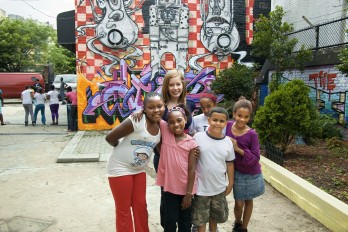
Lillian Lily Wood 11 with students at The Point, a community development organization in the South Bronx this past summer that she worked with as part of the Cornell Urban Scholars Program. See larger image
Just one book
The urban context that Lillian "Lily" Wood '11, a human development major, encountered last summer could not have been further away from high finance or architectural design.
As part of the Urban Scholars Program, Wood worked with a community-development organization in the South Bronx. The neighborhood it serves is the birthplace of hip-hop music, and according to the U.S. Census, is among the poorest parts of New York City.
Wood helped organize a literacy program for young teens and pre-teens in a neighborhood where almost all children eat free lunch and breakfast every day at local schools, and many suffer from asthma, possibly because of diesel exhaust from the 15,000 tractor-trailers that rumble through neighborhood streets each day. Getting them enrolled in a seven-weeklong summer day camp proved difficult because many parents couldn't afford the $275 fee, Wood says.
Her program's center of operations was a narrow loft space, maybe 10 feet by 25 feet, with big dry erase boards bearing the names of the student literacy teams -- Da Champs, Blue Angels, Jaguars and Hyper Tyranus Unleashed.
The goal of the program, which tries to make reading exciting through games and competition, was modest for a student accustomed to Cornell's driven academic culture: To have each child finish just one book, either "Holes" by Luis Sachar or "The Phantom Tollbooth" by Norton Juster, by the end of the summer.

Graduate student Sharath Alampur on the Ithaca campus shortly before heading back to New York City, where he is a student in the Financial Engineering Manhattan program. See larger image
The experience, says Wood, who is considering a career in social justice, "affirms a lot of things for me." Particularly, perhaps, the juxtaposition of poverty with plenty -- that Wood later experienced only a few dozen blocks away when she and her classmates in the Urban Scholars Program went on a walking tour of Midtown Manhattan with guide and adjunct professor Ned Kauffman. An hour later, she was at the College of Architecture, Art and Planning's airy studio space on West 17th Street listening to guest speaker Robert Padgug, an associate professor of health and nutrition services at the City University of New York and an expert on health policy.
Padgug was impressed with all of the Cornell students and the work they are doing across the city. In between bites of a deli sandwich, he summed up why New York City is so valuable as an extension of the Ithaca campus. "I think the best experience they could have is living here for a while," he says. "It's such a different place."
Indeed, New York City is a place where one scholar can perform research on a park bench in Harlem, while another creates a profitable mathematical model for the titans of international finance. It's a place where an intern can find herself working for the top names in media, while another labors to convey her love of reading to some of the most underprivileged young people in the country.
These are experiences that cannot be replicated just anywhere, and that's why Cornell makes sure all of them can happen in New York City.